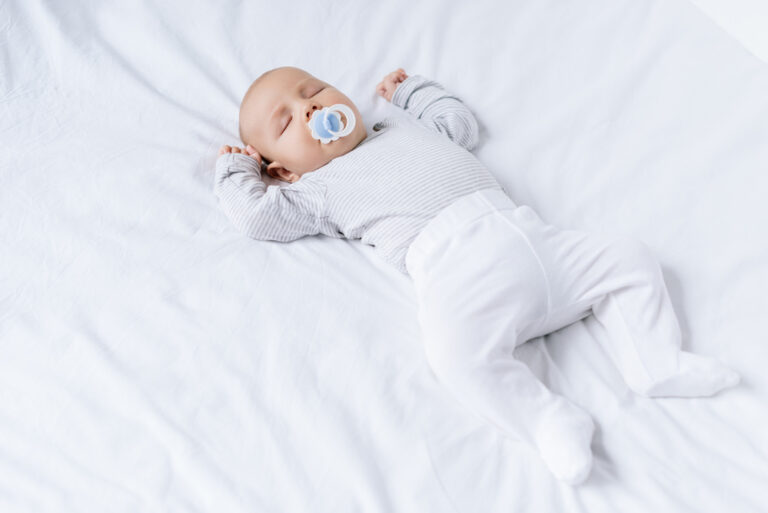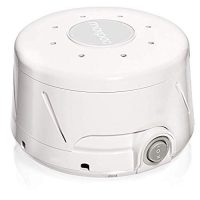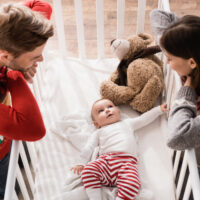Pacifiers, bobos, binkies, or soothers, whatever you like to call them, are a hot topic of conversation in mothers’ groups and on parenting forums. However, are they hygienic? Do they cause dental problems? Will your baby become too attached to them? Read on to learn all about using pacifiers, and when to give them up for good.
A Brief History of the Pacifier
The current types of pacifiers took a few centuries to develop. Before silicon versions were created, a German doctor mentioned pacifiers in a book about raising children in the 15th century. Some years later, German Renaissance painter Albrecht Dürer completed a painting of the Madonna and child. In it, the baby holds a cloth-style pacifier. At that time, the first “pacifiers” were cloth rags filled with meat or lard, then tied into a ball. Other versions were dipped in alcohol to calm or amuse infants. This tradition made its way to the United States by the 19th century, and the rags were treated with whisky, sugar, or honey. These were called “sugar tits.”
Meanwhile, in England, a farmer’s wife gave her baby a corn cob to gnaw on when her nipple became irritated, and discovered that the baby relaxed and went to sleep. Coral, bone, or ivory teethers were then produced, much like the modern day dog’s bone (source). These teething aids remained popular from the 1600’s through the 19th century.
The British also manufactured rubber elastic gummy rings, and topped feeding bottles with rubber nipples. During this time, many parents of the societal upper classes gave their infants silver spoons to chew on as a teething aid. If you’ve ever heard the phrase “born with a silver spoon in his mouth”, this is how it evolved.
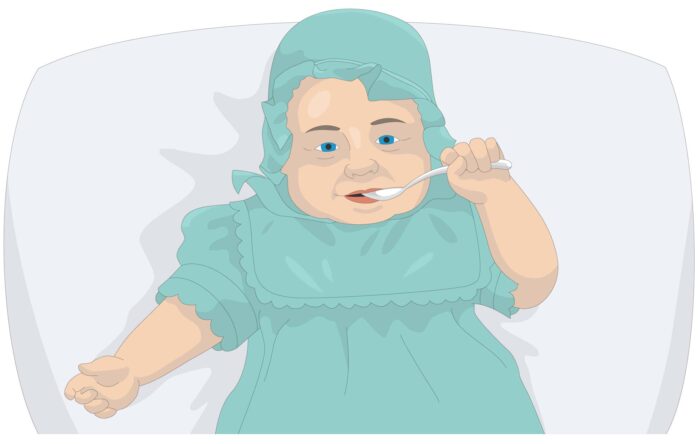
The pacifier as we know it today appeared at the turn of the 20th century. The American department store, Sears Roebuck, published a catalogue in 1902 that featured a rubber teething ring. It had been inspired by the British elastic gummy rings, and fitted with a soft or hard nipple. In this way, the modern-day pacifier was born.
Why It Works
Infants are born with an inherent sucking reflex. It develops around 30 weeks gestation, and gives an infant the coordination required for feeding after birth (source). As a baby feeds from the breast or bottle, this causes contractions in the stomach and intestines to help to empty their digestive tract. You may notice this gastrocolic reflex occurring as your baby passes stool during feedings.
Most of all however, sucking provides much-needed comfort and security, especially during the first six months of life. Crying does not always mean that an infant is hungry; he or she may just need to be soothed (source). Offering a pacifier can give a mother’s sore nipples a break. It might also enable mom to enjoy a few additional hours of sleep.
Good Things About Pacifiers
Pacifiers May Reduce the Risk of SIDS
Although the association is not yet scientifically proven, using a pacifier at bedtime may reduce the risk of Sudden Infant Death Syndrome (SIDS). This may be due to the pacifier creating extra space around baby’s nose and mouth, allowing a better flow of oxygen. Alternatively, babies sleep less soundly when using a pacifier, and can, therefore, easily wake if in danger of suffocating. There are plenty of differing opinions as to why, but most experts agree that using a pacifier might help prevent SIDS.
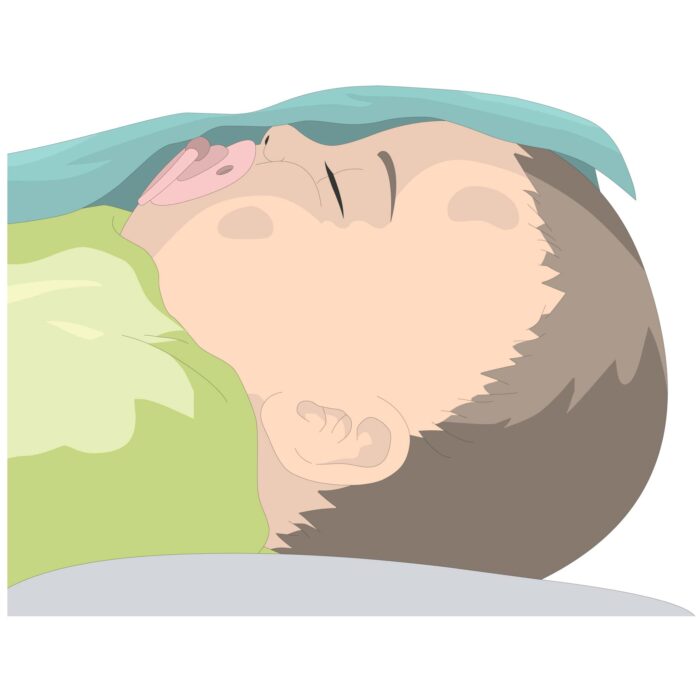
Comfort and Routine
Popping a pacifier into your baby’s mouth shortly before they fall asleep can become a pleasant part of your bedtime routine. Infants and children thrive on routines. Sometimes, sucking on a pacifier is the only thing that calms a distressed baby! In addition, pacifiers can provide frazzled parents with peace and quiet.
You Are in Control
As the parent, you get to decide whether or not to offer your baby a pacifier. You choose the length of time your baby uses it, and when enough is enough. It’s much easier for parents to take away a pacifier than to prevent babies from sucking on their fingers and thumbs.
Bad Things About Using Pacifiers
Problems with Teeth and Oral Hygiene
The American Dental Association and other dental authorities state that pacifiers can change the structure of babies’ mouths, resulting in malocclusion (source). This means that a space remains between the upper and lower teeth when the jaw is closed. In severe cases, the disruption takes on the round shape of the pacifier nipple. This problem typically occurs with pacifier use past age two. It may also occur prior to this age when a pacifier is used excessively.
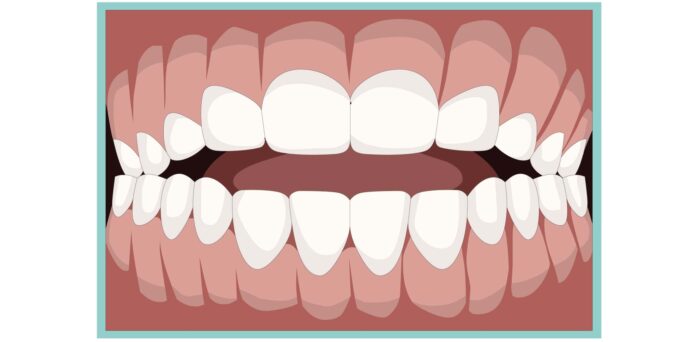
Breastfeeding along with minimal use of a pacifier is associated with fewer ear infections and dental caries (source). It is felt that breastmilk is protective against the bacteria that cause these conditions. When infants suck on a pacifier, it increases the pressure within the Eustachian tube that connects the nasal cavity to the middle ear. This allows nasal congestion or bacteria to travel into the middle ear, and cause an infection (source). In addition, when pacifiers are not cleaned properly or shared between infants, an infection is likely to develop. However, when parents put pacifiers in their own mouths before giving it back to their infant, it may have the immunogenic effect of preventing future environmental allergies (source).
Speech Problems
The verdict is still out on whether or not pacifiers cause speech problems. The dental and ear problems associated with using pacifiers could, however, affect speech. For example, dental malocclusion may impair pronunciation of letters or words. Chronic middle ear fluid reduces hearing, and, in turn, can delay speech onset. Outside of these scenarios, most experts would agree that any speech delays would result from excessive pacifier use (source). If your child keeps a pacifier in his mouth all day, he has less time to practice words and mimic sounds which is very important for language development.
Emotional Maturity
In 2012, a team of psychologists at the University of Wisconsin-Madison suggested that there was a link between repeated pacifier usage, and stunted emotional maturity in boys. They claimed that using a pacifier prevents babies from mimicking facial expressions, and copying body language. When these necessary empathy skills are underdeveloped, this can lead to a lack of emotional maturity later in life.
A subsequent nine year study concluded that facial expression muscles cannot be fully engaged while a pacifier is held in the mouth (source). In addition, the protective pacifier ring partially obstructs the infant’s facial expressions, further limiting social connections. The data on long-term emotional awareness and responsiveness in boys and men, however, was inconclusive.
Nipple Confusion
Some believe that using a pacifier while a baby is learning to breastfeed will lead to problems latching onto the nipple. There is no conclusive evidence that this is the case (source). If you want to be cautious, it is ok to wait until your baby has learned how to breastfeed, and is doing it consistently well before introducing a pacifier.
Addiction
When it is time to wean your toddler from the pacifier, he or she may initially struggle to fall asleep or self soothe without it. This can be particularly difficult if the pacifier has been used outside of naps and bedtime. Breaking this habit can be hard, but not impossible.
Bedtime Benefits
If you choose to give your baby a pacifier, try to introduce it as solely part of the bedtime routine (source). Avoid offering it when your baby is awake and playing. If the majority of the day is pacifier-free, this will reduce the likelihood of your baby developing any of the problems mentioned above. Also, night-time use can be a comforting way to make going to sleep easier for everyone.
Ten Ways to Break the Habit
If you’ve decided that it’s time to eliminate the pacifier from your baby’s life, you can:
- take it away while she’s too little to protest
- read a book on the subject with your child (try “I Want My pacifier” by Tony Ross or “Bea Gives Up Her pacifier” by Jenny Album)
- have a special farewell ceremony
- trade it in for a present at Christmas time
- reduce usage gently, or save it just for special occasions (e.g. at the doctor, on a plane)
- go cold turkey
- Give it to a newborn baby as a present. Explain that pacifiers are for babies and you are a big boy/girl now. (This is great advice that I learned from Susie at SleepBabyLove.com)
- if there’s no rush, just wait to see if your baby loses interest on his own
Pacifier Weaning No-Gos
Avoid taking the pacifier away when significant changes or emotional upheavals are happening at home (i.e. the arrival of a new baby, moving to a new house, parent returning to work). Also, save the weaning process for when your baby is healthy. If your child still uses a pacifier when most kids have left it behind, don’t let anyone make fun of your child for still needing it (source). Being teased or mocked won’t help the process; it will just make your child feel insecure, and need the pacifier even more.
What Worked For You?
Did your baby love the pacifier or completely reject it? How did you break the habit? We’d love to hear from you!
